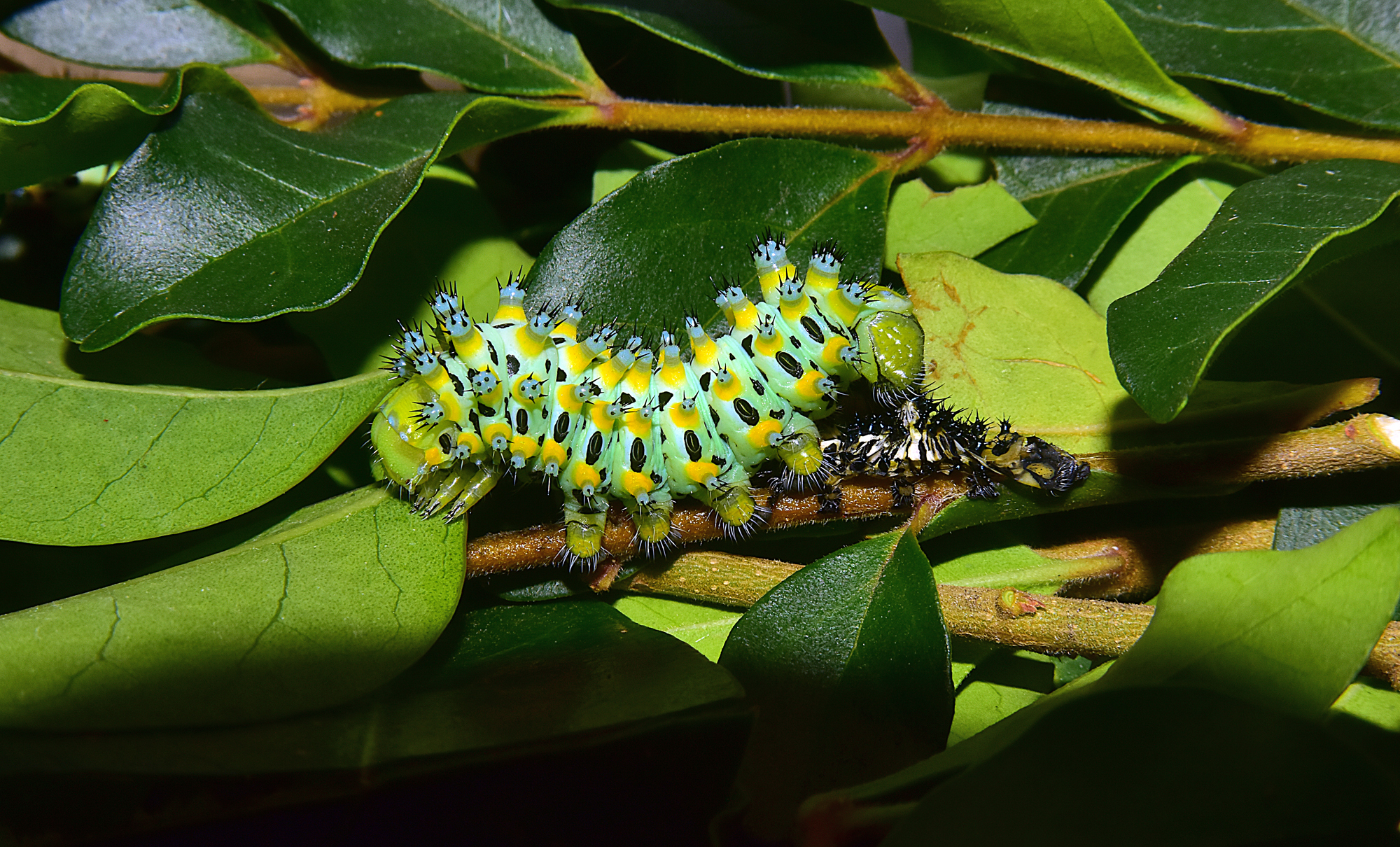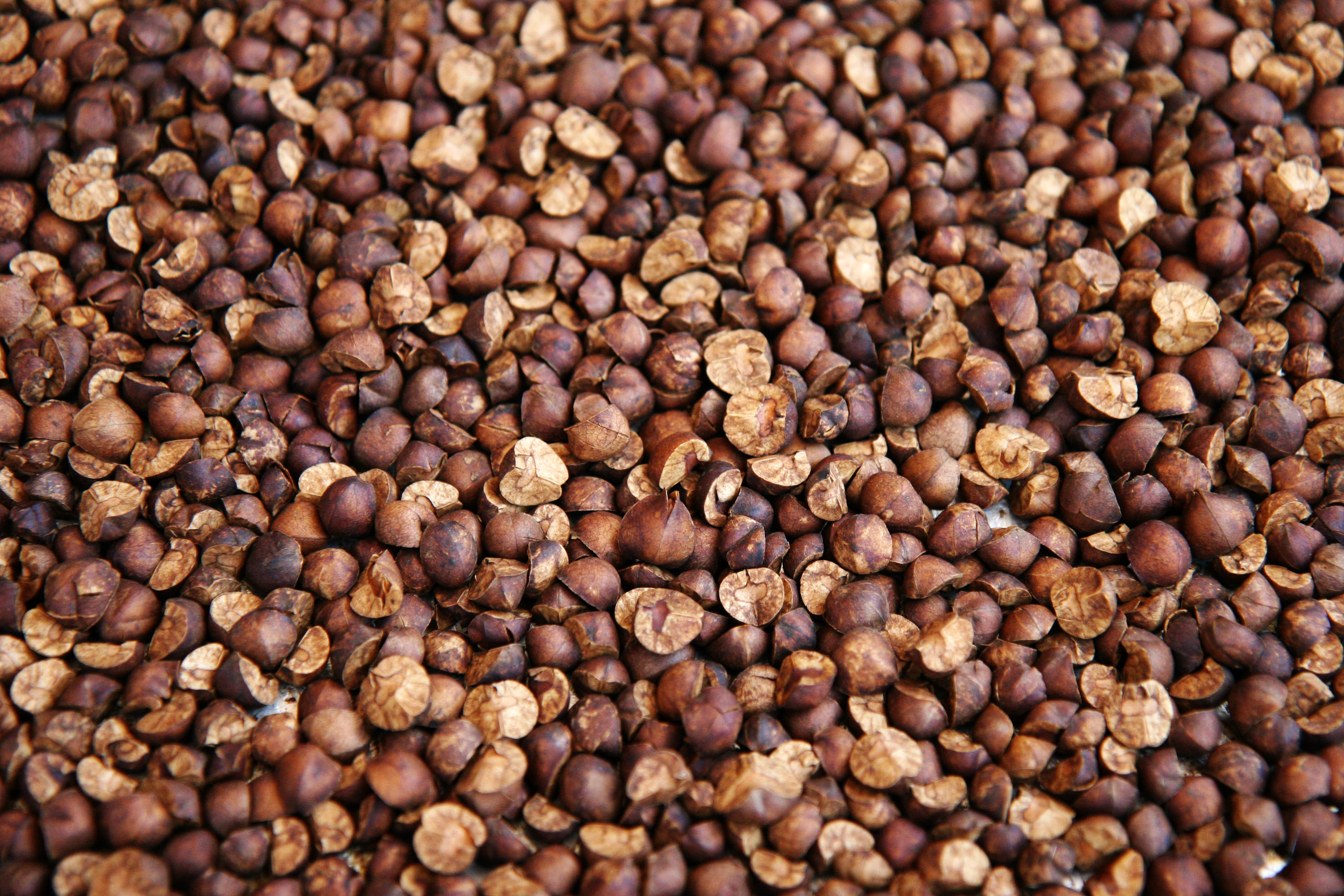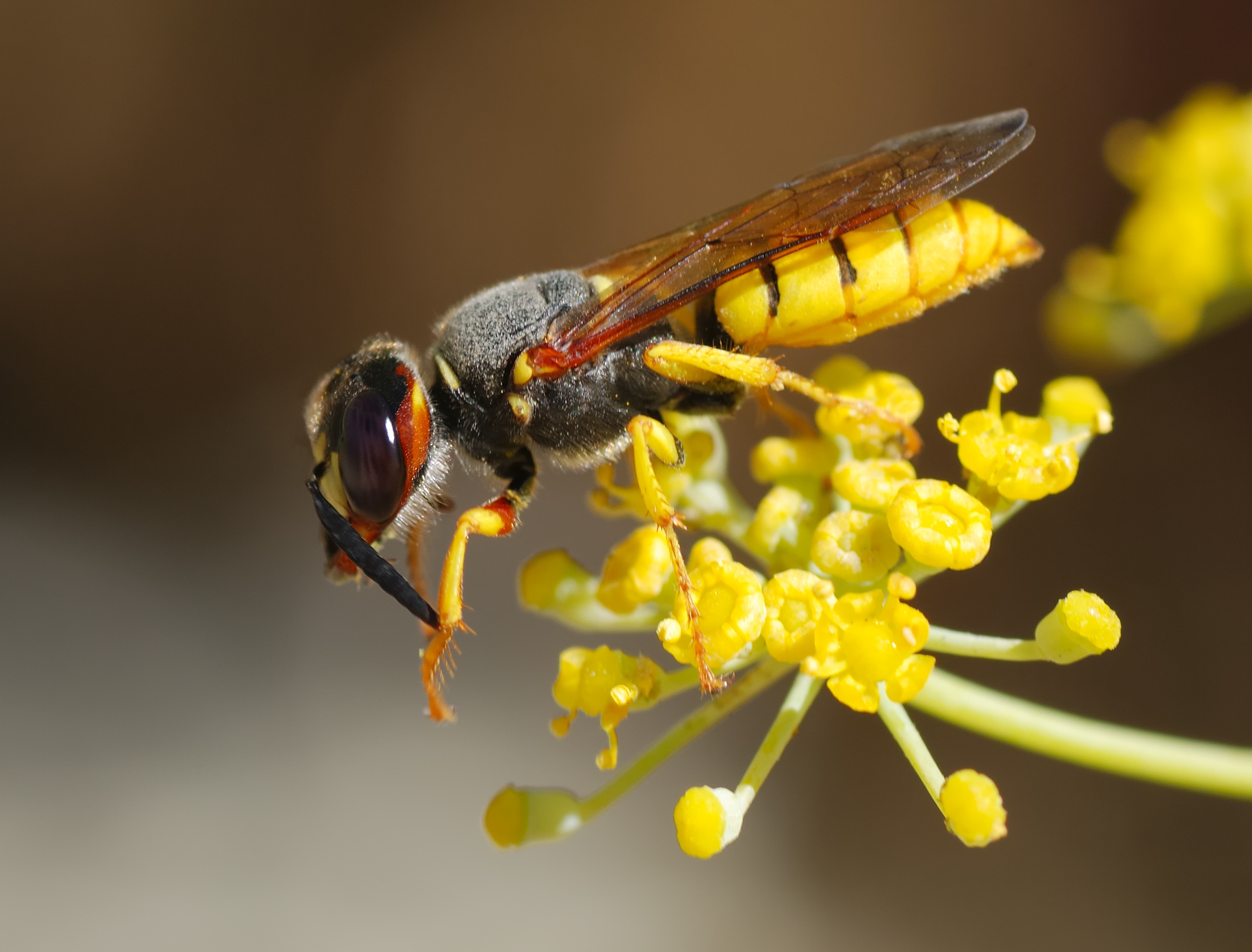Eupackardia Calleta on:
[Wikipedia]
[Google]
[Amazon]
''Eupackardia'' is a

 The adult calleta silkmoth has a black body with a red collar and red on the back of the thorax. The wings, which normally span 8-11 centimetres, are black with conspicuous white post-median lines which happen to be wider in females. They can also have large triangular white spots on their wings however, some may not.
Caterpillars or larvae are normally bright green in colour with white stripes as well as have black scoli sets (spike-like projections) with blue and orange bases, though these colours may vary.
These larvae are normally very brightly coloured because they contain biogenetic chemicals that help to repel predators.
The adult calleta silkmoth has a black body with a red collar and red on the back of the thorax. The wings, which normally span 8-11 centimetres, are black with conspicuous white post-median lines which happen to be wider in females. They can also have large triangular white spots on their wings however, some may not.
Caterpillars or larvae are normally bright green in colour with white stripes as well as have black scoli sets (spike-like projections) with blue and orange bases, though these colours may vary.
These larvae are normally very brightly coloured because they contain biogenetic chemicals that help to repel predators.



 Raccoons, opossum and possibly other species of the order Rodentia tend to tear apart the cocoons of the calleta silkmoth. The larvae secrete a defensive chemical protection that normally wards off predators, except in the case of wasps, which tend to be unaffected by the larvae's protection.
Raccoons, opossum and possibly other species of the order Rodentia tend to tear apart the cocoons of the calleta silkmoth. The larvae secrete a defensive chemical protection that normally wards off predators, except in the case of wasps, which tend to be unaffected by the larvae's protection.
monotypic
In biology, a monotypic taxon is a taxonomic group (taxon) that contains only one immediately subordinate taxon. A monotypic species is one that does not include subspecies or smaller, infraspecific taxa. In the case of genera, the term "unispec ...
moth genus in the family Saturniidae
Saturniidae, commonly known as saturniids, is a family of Lepidoptera with an estimated 2,300 described species. The family contains some of the largest species of moths in the world. Notable members include the emperor moths, royal moths, and gi ...
erected by Theodore Dru Alison Cockerell
Theodore Dru Alison Cockerell (1866–1948) was an American zoology, zoologist, born at Norwood, England, and brother of Sydney Cockerell. He was educated at the Middlesex Hospital Medical School, and then studied botany in the field in Colorad ...
in 1912. Its only species, ''Eupackardia calleta'', the calleta silkmoth, was described by John O. Westwood
John Obadiah Westwood (22 December 1805 – 2 January 1893) was an English entomologist and archaeologist also noted for his artistic talents. He published several illustrated works on insects and antiquities. He was among the first entomologist ...
in 1853. It is found in Mexico
Mexico (Spanish: México), officially the United Mexican States, is a country in the southern portion of North America. It is bordered to the north by the United States; to the south and west by the Pacific Ocean; to the southeast by Guatema ...
, Guatemala
Guatemala ( ; ), officially the Republic of Guatemala ( es, República de Guatemala, links=no), is a country in Central America. It is bordered to the north and west by Mexico; to the northeast by Belize and the Caribbean; to the east by H ...
, as well as in the states such as; Arizona
Arizona ( ; nv, Hoozdo Hahoodzo ; ood, Alĭ ṣonak ) is a state in the Southwestern United States. It is the 6th largest and the 14th most populous of the 50 states. Its capital and largest city is Phoenix. Arizona is part of the Fou ...
, New Mexico
)
, population_demonym = New Mexican ( es, Neomexicano, Neomejicano, Nuevo Mexicano)
, seat = Santa Fe
, LargestCity = Albuquerque
, LargestMetro = Tiguex
, OfficialLang = None
, Languages = English, Spanish ( New Mexican), Navajo, Ker ...
, and Texas
Texas (, ; Spanish language, Spanish: ''Texas'', ''Tejas'') is a state in the South Central United States, South Central region of the United States. At 268,596 square miles (695,662 km2), and with more than 29.1 million residents in 2 ...
.
The wingspan
The wingspan (or just span) of a bird or an airplane is the distance from one wingtip to the other wingtip. For example, the Boeing 777–200 has a wingspan of , and a wandering albatross (''Diomedea exulans'') caught in 1965 had a wingspan of ...
is normally , however, some specimens have been reported to exceed 5 inches.
The larvae mainly feed on ''Fraxinus
''Fraxinus'' (), common name, commonly called ash, is a genus of flowering plants in the olive and lilac family, Oleaceae. It contains 45–65 species of usually medium to large trees, mostly deciduous, though a number of Subtropics, subtropic ...
'' species, ''Leucophyllum frutescens
''Leucophyllum frutescens'' is an evergreen shrub in the figwort family, Scrophulariaceae, native to the U.S. state of Texas, where it is the official "State Native Shrub of Texas", and to the states of Coahuila, Nuevo León, and Tamaulipas in ...
'', ''Sapium
''Sapium'' is a genus of flowering plants in the family Euphorbiaceae. It is widespread across most of Latin America and the West Indies. Many Old World species were formerly included in the genus, but recent authors have redistributed all the ...
biloculare'' and ''Fouquieria splendens
''Fouquieria splendens'' (commonly known as ocotillo (), but also referred to as buggywhip, coachwhip, candlewood, slimwood, desert coral, Jacob's staff, Jacob cactus, and vine cactus) is a plant indigenous to the Sonoran Desert and Chihuahuan ...
''.
Description

 The adult calleta silkmoth has a black body with a red collar and red on the back of the thorax. The wings, which normally span 8-11 centimetres, are black with conspicuous white post-median lines which happen to be wider in females. They can also have large triangular white spots on their wings however, some may not.
Caterpillars or larvae are normally bright green in colour with white stripes as well as have black scoli sets (spike-like projections) with blue and orange bases, though these colours may vary.
These larvae are normally very brightly coloured because they contain biogenetic chemicals that help to repel predators.
The adult calleta silkmoth has a black body with a red collar and red on the back of the thorax. The wings, which normally span 8-11 centimetres, are black with conspicuous white post-median lines which happen to be wider in females. They can also have large triangular white spots on their wings however, some may not.
Caterpillars or larvae are normally bright green in colour with white stripes as well as have black scoli sets (spike-like projections) with blue and orange bases, though these colours may vary.
These larvae are normally very brightly coloured because they contain biogenetic chemicals that help to repel predators.
Life cycle
Adult ''E. calleta'' emerge in the evening and may be mating as early as 7:30 am the next morning. Males are diurnal while females are nocturnal. Females lay eggs starting at dusk of the same day and the eggs are deposited in clumps on surfaces of host plant leaves. Caterpillars spray a defensive secretion from their integumental glands. Young caterpillars, typically the 1st to 3rd larval stages, feed gregariously, while the older caterpillars of the 4th and 5th larval stages are usually solitary feeders. Cocoons are normally spun near the ground and in the shade and is attached to a twig by a short silken loop.
Diet
''Eupackardia calleta'' caterpillars feed on ceniza (''Leucophyllum frutescens
''Leucophyllum frutescens'' is an evergreen shrub in the figwort family, Scrophulariaceae, native to the U.S. state of Texas, where it is the official "State Native Shrub of Texas", and to the states of Coahuila, Nuevo León, and Tamaulipas in ...
''), ash (''Fraxinus
''Fraxinus'' (), common name, commonly called ash, is a genus of flowering plants in the olive and lilac family, Oleaceae. It contains 45–65 species of usually medium to large trees, mostly deciduous, though a number of Subtropics, subtropic ...
''), Mexican jumping bean
Mexican jumping beans (also known as ' in Spanish) are seed pods that have been inhabited by the larva of a small moth (''Cydia saltitans'') and are native to Mexico. The "bean" is usually tan to brown. They are from the shrub '' Sebastiania pa ...
(''Sapium
''Sapium'' is a genus of flowering plants in the family Euphorbiaceae. It is widespread across most of Latin America and the West Indies. Many Old World species were formerly included in the genus, but recent authors have redistributed all the ...
biloculare'') and ocotillo (''Fouquieria splendens
''Fouquieria splendens'' (commonly known as ocotillo (), but also referred to as buggywhip, coachwhip, candlewood, slimwood, desert coral, Jacob's staff, Jacob cactus, and vine cactus) is a plant indigenous to the Sonoran Desert and Chihuahuan ...
''), while adults do not feed at all.

Habitat, season and distribution
''Eupackardia calleta'' ranges across southernTexas
Texas (, ; Spanish language, Spanish: ''Texas'', ''Tejas'') is a state in the South Central United States, South Central region of the United States. At 268,596 square miles (695,662 km2), and with more than 29.1 million residents in 2 ...
, Mexico
Mexico (Spanish: México), officially the United Mexican States, is a country in the southern portion of North America. It is bordered to the north by the United States; to the south and west by the Pacific Ocean; to the southeast by Guatema ...
, Guatemala
Guatemala ( ; ), officially the Republic of Guatemala ( es, República de Guatemala, links=no), is a country in Central America. It is bordered to the north and west by Mexico; to the northeast by Belize and the Caribbean; to the east by H ...
, Arizona
Arizona ( ; nv, Hoozdo Hahoodzo ; ood, Alĭ ṣonak ) is a state in the Southwestern United States. It is the 6th largest and the 14th most populous of the 50 states. Its capital and largest city is Phoenix. Arizona is part of the Fou ...
, and New Mexico
)
, population_demonym = New Mexican ( es, Neomexicano, Neomejicano, Nuevo Mexicano)
, seat = Santa Fe
, LargestCity = Albuquerque
, LargestMetro = Tiguex
, OfficialLang = None
, Languages = English, Spanish ( New Mexican), Navajo, Ker ...
. In the southeastern mountains of Arizona they are mostly seen from July to August. In central Arizona to Mexico they are seen from October to January, and in South Texas they are seen from September to November as well as March to April.
They normally make their habitats in thorn scrubs, foothills and canyons of desert mountain ranges and dry deserts. Threats
Predators
 Raccoons, opossum and possibly other species of the order Rodentia tend to tear apart the cocoons of the calleta silkmoth. The larvae secrete a defensive chemical protection that normally wards off predators, except in the case of wasps, which tend to be unaffected by the larvae's protection.
Raccoons, opossum and possibly other species of the order Rodentia tend to tear apart the cocoons of the calleta silkmoth. The larvae secrete a defensive chemical protection that normally wards off predators, except in the case of wasps, which tend to be unaffected by the larvae's protection.
Parasitoids
A parasitoid is an insect that completes its larval development within the body of another insect, eventually killing its host. The most common parasitoid is the wasp. Compared to other large Saturniidea, ''E. calleta'' does not appear to be attacked by many parasitoid species, however some reports have been seen.Uses of ''Eupackardia calleta'' cocoons
The cocoons of ''Eupackardia calleta'' are often used for ankle rattles and medicinal necklaces in certain American Indian ceremonies. The Yaqui Indians in Arizona and Mexico for example, call these rattles "tenabares", or "tenevoim". They are made in pairs and worn around the ankles or on both lower legs.References
External links
* * {{Taxonbar , from=Q135026 Saturniinae Monotypic moth genera Moths described in 1853 Moths of North America Moths of Central America Fauna of the Rio Grande valleys